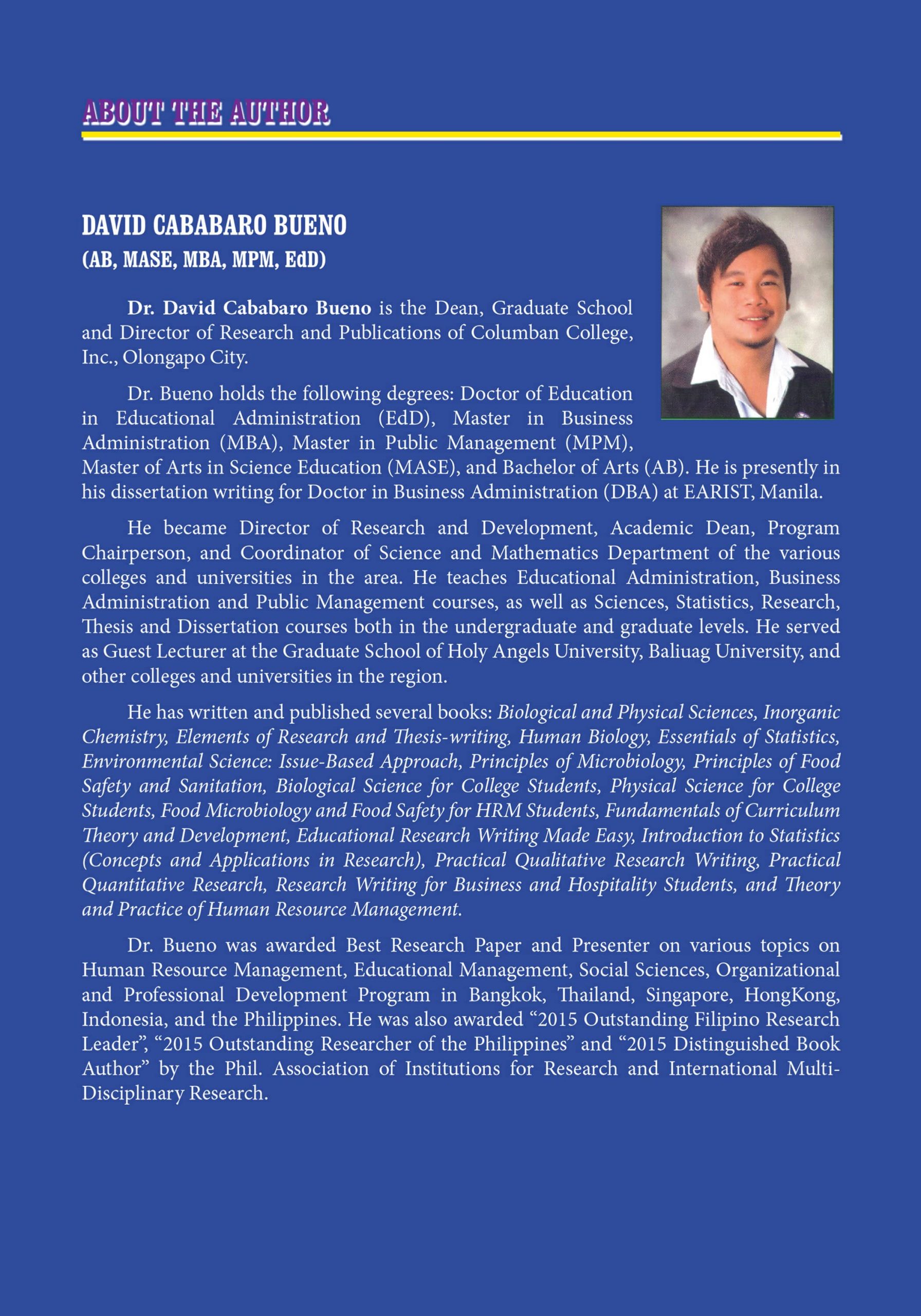Organization and Management For Senior High School
₱375.00
ISBN: 978-621-409-033-4
Author: David C. Bueno
Description
ISBN: 978-621-409-033-4
Author: David C. Bueno
Additional information
| Book Type | Hard Copy, e-book |
|---|
TABLE OF CONTENTS
TABLE OF CONTENTS
Chapter 1 Nature and Concept of Management.……………….. 1
Management……………………………………………………………………………….. 1
Historical Development of Management ……………………………………. 2
Principles of Management…………………………………………………………… 4
Managerial Thoughts and Theories……………………………………………… 8
Functions of Manager…………………………………………………………………. 10
Roles of the Manager…………………………………………………………………… 11
Social Responsibilities of the Manager………………………………………… 13
Managerial Skills…………………………………………………………………………. 16
How to Be a Successful Manager…………………………………………………. 16
Worksheet #1……………………………………………………………………………….. 19
Chapter 2 The Firm and Its Environment…………………………… 25
Nature of the Business Environment…………………………………………… 25
Organizational Structure ……………………………………………………………. 26
The Task Environment………………………………………………………………… 27
Features of the Business Environment…………………………………………. 27
The Levels of Business Environment……………………………………………. 29
Organizational Approach to Environmental Challenges……………… 29
Environmental Forces and Environmental Scanning…………………… 30
Environmental Analysis………………………………………………………………. 30
Techniques for Analyzing the Business Environment …………………. 33
Local and International Business Environment…………………………… 35
Environmental Challenges of International Business…………………… 37
Management Processes in a Global environment ……………………….. 39
Phases of Economic Development………………………………………………. 40
Forms of Business Organizations………………………………………………… 41
Resources Business Use……………………………………………………………….. 41
Characteristics of Business………………………………………………………….. 41
Objectives of Business…………………………………………………………………. 42
Who Benefits from a Business? …………………………………………………… 42
Forms of Business……………………………………………………………………….. 43
Worksheet #2……………………………………………………………………………….. 53
chapter 3 Forecasting and Planning…………………………………. 57
Nature of Forecasting and Planning…………………………………………….. 57
Features of Planning……………………………………………………………………. 58
Advantages of Planning………………………………………………………………. 58
Disadvantages of Planning………………………………………………………….. 58
Benefits of Planning……………………………………………………………………. 59
Problems in Planning………………………………………………………………….. 59
Planning at Different Levels in the Firm……………………………………… 60
Types of Plans……………………………………………………………………………… 60
The Planning Process………………………………………………………………….. 61
Planning Techniques and Tools…………………………………………………… 61
Application of Planning Tools and Techniques……………………………. 62
The Six P’s of Planning………………………………………………………………… 62
Decision-Making………………………………………………………………………… 63
Steps in Decision-Making…………………………………………………………… 63
Worksheet #3………………………………………………………………………………. 65
chapter 4 Organizing………………………………………………………….. 71
Nature of Organizing………………………………………………………………….. 71
Advantages of Organizing…………………………………………………………… 72
What is Organization?………………………………………………………………… 73
Meaning of Organization Structure…………………………………………….. 73
Objectives of Organizational Structure……………………………………….. 74
Types of Organization Structures………………………………………………… 74
Dimensions of Organizational Structure……………………………………… 75
Advantages and Disadvantages of Specialization of Labor…………… 76
Composition and Members in the Organizational Structure……….. 76
Organization Theories and Application……………………………………….. 79
Relevance of Organization…………………………………………………………… 80
Elements of Good Organization………………………………………………….. 80
Rationale for Studying Organizations………………………………………….. 81
Delegation…………………………………………………………………………………… 82
Formal and Informal Organizations……………………………………………. 85
Worksheet #4……………………………………………………………………………….. 87
chapter 5 Staffing……………………………………………………………….. 93
Nature of Staffing………………………………………………………………………… 93
Recruitment………………………………………………………………………………… 94
Bases for Recruitment…………………………………………………………………. 95
Selection……………………………………………………………………………………… 95
Placement…………………………………………………………………………………… 95
Training and Development………………………………………………………….. 96
Performance Appraisal………………………………………………………………… 96
Development………………………………………………………………………………. 97
Employee Movement-Promotion and Transfer……………………………. 97
Remuneration/Salaries and Wages Administration……………………… 97
Staff Welfare………………………………………………………………………………… 97
Employee Relations…………………………………………………………………….. 98
Reward System……………………………………………………………………………. 98
Trans-national Labor Mobility…………………………………………………….. 99
Ethical Human Resource Management……………………………………….. 99
Worksheet #5……………………………………………………………………………….. 101
chapter 6 Leading………………………………………………………………… 107
Scope of Directing and Leading…………………………………………………… 107
Leadership………………………………………………………………………………….. 108
Qualities of a Good Leader………………………………………………………….. 108
Motivation………………………………………………………………………………….. 109
Ways of Looking at Motivation……………………………………………………. 109
Characteristics of the Individual…………………………………………………. 110
Types of Reinforcement………………………………………………………………. 112
Leadership Theories……………………………………………………………………. 112
Leadership Function…………………………………………………………………… 114
Leadership Styles………………………………………………………………………… 118
Leadership Development…………………………………………………………….. 118
Communication………………………………………………………………………….. 119
Communication Process……………………………………………………………… 120
Reasons for Communication………………………………………………………. 120
Importance of Communication…………………………………………………… 121
The Communication Flow…………………………………………………………… 121
Types of Communication……………………………………………………………. 122
Communication Barriers…………………………………………………………….. 122
Minimizing Barriers……………………………………………………………………. 123
Management of Change and Diversity………………………………………… 123
Leader’s Role for Managing Change…………………………………………….. 124
Eight Errors Common to Organizational Change Efforts
and Their Consequences……………………………………………………… 124
Consequences …………………………………………………………………………….. 124
Roles and Responsibilities for Change…………………………………………. 124
Steps to Effective Change Management……………………………………….. 125
Techniques of Human Relations for Change Management………….. 126
Filipino and Foreign Cultures: A Leadership Challenge………………. 127
Intercultural Management…………………………………………………………… 127
Culture on Global Teams…………………………………………………………….. 129
Stages of Culture Shock……………………………………………………………….. 129
Worksheet #6………………………………………………………………………………. 131
chapter 7 Controlling………………………………………………………… 137
Nature of Management Control…………………………………………………… 137
Characteristics of Control…………………………………………………………… 138
The Elements of Control……………………………………………………………… 138
Requirements for Effective Control…………………………………………….. 139
Signs Showing that Control are Inadequate or Ineffective……………. 140
The Link between Planning and Controlling……………………………….. 140
Control Methods and Systems…………………………………………………….. 140
Process of Controlling…………………………………………………………………. 142
Kinds of Control…………………………………………………………………………. 142
Organizational and Operational Control…………………………………….. 144
Role of Budget Application in Management Control ………………….. 145
Control by Audit…………………………………………………………………………. 146
Uses of Accounting as an Information System…………………………….. 147
The Accounting Process………………………………………………………………. 148
Worksheet #7……………………………………………………………………………….. 149
Chapter 8 Introduction to the Various Functional Areas
of Management…………………………………………………… 155
Human Resource Management (HRM)………………………………………. 155
Functions of Human Resource Management………………………………. 156
Activities of Human Resource Management……………………………….. 156
Marketing Management………………………………………………………………. 158
Functions of Marketing……………………………………………………………….. 159
Operations Management…………………………………………………………….. 160
Objectives of Operations Management……………………………………….. 161
Managing Global Operations………………………………………………………. 162
Financial Management (FM)………………………………………………………. 163
Major Areas & Concepts of Financial Management…………………….. 164
Information and Communications Technology Management……… 165
Impact of ICT……………………………………………………………………………… 166
Response of Industry and Government
to the Information Society…………………………………………………… 166
What are the Effects of these Developments
on the User Community?……………………………………………………….. 167
Communication-based Technologies …………………………………………. 168
Worksheet #8……………………………………………………………………………….. 169
chapter 9 Special Topics in Management…………………………… 171
Small Business Management and Entrepreneurship…………………….. 171
Criteria Used to Measure Size of Business…………………………………… 172
General Criteria for Defining Small Business………………………………. 172
Definition of Entrepreneurship…………………………………………………… 173
Entrepreneurship………………………………………………………………………… 173
Entrepreneur Vs Small Business………………………………………………….. 174
Objective, Strategy and Operational Planning in Small Business…. 175
Variables that affect attitudes towards Growth…………………………….. 176
Social Responsibilities…………………………………………………………………. 176
The Advantages of Small Businesses……………………………………………. 178
Disadvantages of Small Business…………………………………………………. 179
Category of Entrepreneur……………………………………………………………. 179
Four Reasons for Becoming an Entrepreneur……………………………… 179
Characteristics of Entrepreneur and Success Trait……………………….. 179
Effect of Small Business on the Economy…………………………………….. 180
Small Business in the Major Industries………………………………………… 181
Small Business Strength in Number…………………………………………….. 181
Problems Facing Small Business and Causes of Failure……………….. 182
Family Business Enterprise…………………………………………………………. 183
What Makes a Family Business?………………………………………………….. 183
Management Activities, Style and Characteristics……………………….. 183
Growth……………………………………………………………………………………….. 184
Possible Problems and Concerns…………………………………………………. 184
Successful Transition…………………………………………………………………… 185
Other Issues Related to Family Business Transitions……………………. 186
Starting a Business: Legal Forms and Requirements……………………. 187
Business Operation……………………………………………………………………… 187
Business Planning……………………………………………………………………….. 188
Requirements for the Business Planning……………………………………… 188
Preparing a Business Plan……………………………………………………………. 191
Government Regulations and Requirements……………………………….. 192
Competition Rules/Consumer Protection…………………………………… 192
Import and Export Controls ………………………………………………………. 192
Worksheet #9……………………………………………………………………………….. 195









